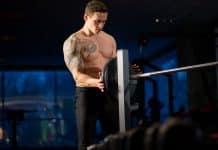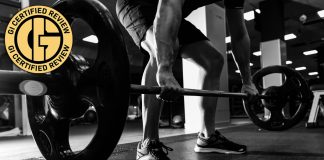
Performing cable flyes with a high setup emphasizes your lower pecs.
Pushups and bench presses are fundamental for crafting well-defined pectoral muscles in any strength training regime. However, paying attention to the value of cable exercises for chest development is crucial. Cable machines offer a unique advantage by applying consistent tension throughout the entire range of motion, effectively targeting the pecs in a way that traditional exercises might not. The high cable fly is among the most effective isolation exercises for the chest. This exercise excels at placing uninterrupted tension on the chest muscles throughout the movement, fostering significant muscle growth (1).
This article delves into the high cable fly, highlighting its benefits for athletes and providing a detailed, step-by-step guide to executing the exercise with proper form. Additionally, we’ll introduce some effective alternatives that target similar muscle groups, offering strategies to maximize the efficiency of your workouts.
Techniques & Muscles Worked
The high cable fly is an isolation movement that works the upper body muscles. It primarily targets the chest muscles, emphasizing the lower pecs. Its secondary muscles include the triceps and shoulders. During this exercise, core muscles like the abs and obliques also serve as stabilizers. You can perform the high cable fly using a functional trainer with a cable pulley attached to the highest level on both sides.
Athletes can do this exercise standing or sitting, but remember that form is essential. If standing, your knees should be slightly bent as your legs assume a staggered stance, so the weight doesn’t pull you backward. Here’s a step-by-step guide on how to perform the high cable fly correctly while standing.
- Set the cable pulley to its highest level on the functional trainer and select your desired weight.
- Stand straight and grab the D-handles with a neutral grip on each side of the functional trainer.
- Next, step forward so your feet take a staggered stance.
- This is your starting position. Keep your back straight, tighten your core, and pull and squeeze your shoulder blades back while maintaining a slight bend at your elbows.
- Exhale, and with a controlled movement, pull the D-handles forward while flexing your chest, bringing your hands together, forming a V-shape just above your belly.
- Pause for about 2 seconds and slowly reverse the movement, allowing your hands to open and stretching your pecs back to the starting position, making it one rep.
- Perform for as many reps as you desire.
Benefits
The high cable fly is a chest fly variation that builds your upper body muscles. Using a cable machine for this exercise helps with balance and can allow you to focus more on the target muscles. Below is a list of benefits you derive from performing this exercise.
Build the Lower Pecs
The high cable fly exercise provides an excellent option for building the lower pecs. It primarily targets the pecs but also works the triceps and delts. During this routine, you stretch and flex your pecs, continually tensing the chest, leading to muscle growth.
Better Mind-Muscle Connection
This chest-building routine is an isolation exercise. It eliminates other muscles and solely focuses on target muscles. This increases your mind-muscle connection, which induces muscle hypertrophy in target muscles.
Greater Range of Motion
To do this exercise, you use a cable machine, which gives you a greater range of motion than other forms of training. The constant stretching and squeezing allow you to hit your pec muscles differently and sculpt your chest (2). Over time, doing the high cable fly will increase your range of motion.
Activates Core Muscles
Strengthening the core is essential when performing the high cable fly. This exercise activates your core muscles, providing proper coordination and balance. This helps with balance and stability while reducing your chances of injuries.
High Cable Fly Alternatives
The high cable fly is a strength training exercise for developing a stable upper body and massive chest. However, limiting yourself to only this routine exposes you to the chance of hitting a training plateau. Here’s a list of alternate exercises for building similar upper-body muscles.
Incline Bench Press
The incline bench press is an excellent compound movement for building the chest, shoulders, and tricep muscles. An incline while pressing allows you to focus more on the upper pecs. You can perform this routine with free weights like dumbbells, kettlebells, or barbells. You can also do this with a Smith machine for more stability and balance.
Svend Press
The Svend press is a weight-training exercise that targets your chest muscles. To do this routine, you maintain an isometric hold throughout the movement. You can also do the Svend press with weight plates, kettlebells, and dumbbells.
Wide Push-Up
Wide push-ups are a bodyweight exercise that targets the chest, shoulders, and triceps and helps build core muscles. You can use resistance bands or weighted vests for more resistance and extra gains during this exercise.
FAQs
What do high cable flyes work?
The high cable fly is an isolation movement that works the chest muscles, primarily targeting the lower pec muscles. This includes other secondary muscles like the shoulders and triceps. This exercise also places constant tension on your core.
How do you do the cable fly correctly?
Your form is essential when doing this exercise. Ensure the cable pulleys are attached to the highest level on the functional trainer, and remember to stagger your feet. You should also avoid arching your back to help with your balance. Check the exercise guide above for more details on performing this exercise safely.
Can you build the chest with just cable flyes?
Yes, you can build a massive chest with cable flyes. As an added advantage, performing a high cable fly focuses more on your chest, eliminating other muscles and inducing muscle hypertrophy. The cable machine also places constant tension on target muscles, which research shows can play a role in optimizing muscle growth (1).
Follow us on Instagram, Facebook, and Twitter for more exercise guides!
References
- Burd, N. A., Andrews, R. J., West, D. W., Little, J. P., Cochran, A. J., Hector, A. J., Cashaback, J. G., Gibala, M. J., Potvin, J. R., Baker, S. K., & Phillips, S. M. (2012). Muscle time under tension during resistance exercise stimulates differential muscle protein sub-fractional synthetic responses in men. The Journal of physiology, 590(2), 351–362. https://doi.org/10.1113/jphysiol.2011.221200
- Signorile, J. F., Rendos, N. K., Heredia Vargas, H. H., Alipio, T. C., Regis, R. C., Eltoukhy, M. M., Nargund, R. S., & Romero, M. A. (2017). Differences in Muscle Activation and Kinematics Between Cable-Based and Selectorized Weight Training. Journal of strength and conditioning research, 31(2), 313–322. https://doi.org/10.1519/JSC.0000000000001493















